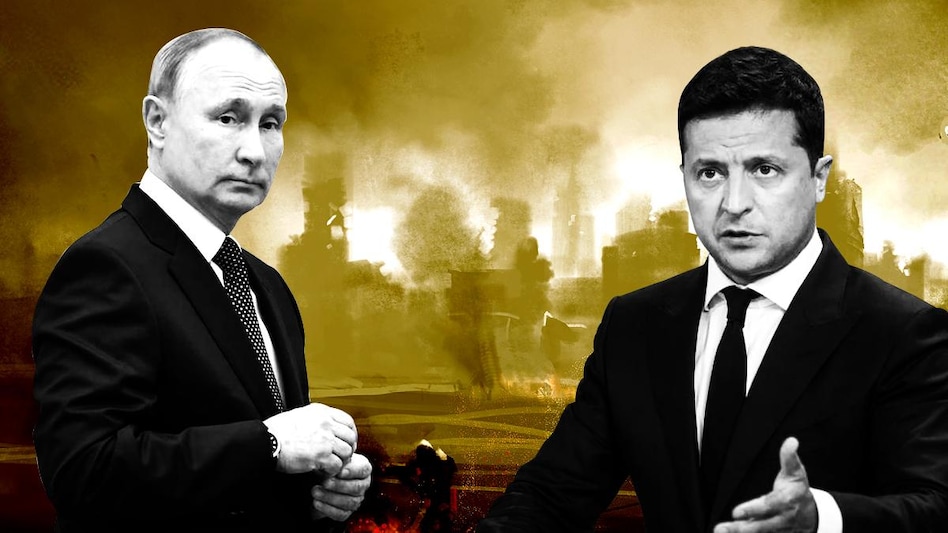Before getting to the real deal as to why an all-out war is starting as the whole world is already struggling to recover from the economic repercussions of a pandemic that had been going on for more than two years now with a heavy cost, it is worthwhile to historically, structurally and strategically contextualize this invasion.
A Brief Note on the Ukrainian Strategic Miscalculations & the Fluidity of the International System
As Ukrainians now rush to flee their country that is under a full-scale Russian invasion, the West led by the US is using its hardly ‘out of the box’ sanctions weapon against the Russians (albeit, with a historic degree this time: expulsion from Swift) in a complicated and historic scene that marks the first major military action in Europe since the end of WWII in 1945, and strongly refreshes the cold war memory. The situation is exceptional on so many fronts: First, from the scale of the Ukrainians exodus into neighboring countries, we are looking at a buildup of migration crisis, but of Europeans this time. Second, it is a very harsh exemplary of how failed strategic calculation could put a country in an existential threat. The strategic miscalculation was on the Ukrainian side. It was when Kyiv agreed in 1994 under the Budapest memorandum to forgo its nuclear weapons (was the third biggest in the world at that time) with promises from Russia of non-interference and promises from the west, particularly the US of protections. Another major strategic mistake was when it kept itself aspiring to join the NATO, accepting military aid from the west and infuriating in the process a mighty neighbor and an ex-global super- power that is Russia without being protected as a NATO member. In fact, speaking of global super -powers, the current developments in the international system is quite historic and this takes us to the third point: the internationals system polarity. For 30 years since the dismantle of the UUSR with the fall of berlin wall in 1991, the system changed from being bi-polar with the USSR and the US as the two global super- powers to being a uni-polar world with the US emerging as the Hegemon. This hegemony moment was seriously interrupted by the Chinese rise to power with the turn of the century to the extent that made many talks about a bi-polar world with the US and China as the two poles. During that time Russia took a back seat till it revised the situation in Crimea in 2014 uncovering its strong intent, resolve and capability to re-emerge again as a global player. Of course, currently the situation took a much more serious turn, the system polarity had never been as fluid since WWII. The stagnation is over and Russia is revising the status quo and we are witnessing either the re-birth of a bi-polar world or the emergence of a tri-polar world with China maintaining its strength vis-à-vis the US and Russia. These changes take years to shape but we are definitely witnessing a polarity shift.
Now, let’s try to understand what brought the Red Army (to use the USSR lingo) to Kyiv
- NATO Expansion Eastwards in Europe aka the “Open Door Policy”

© Nato – DW
The NATO, the trans-Atlantic military alliance, was founded in 1949 specifically to militarily counter the USSR in Europe, and even after the breakup of the USSR in 1991 it had observed its “open door policy” whereby any qualified European country could join, much to the dismay of the USSR and later on Russia. Since 1990, NATO gone through rounds of expansion to include Eastern and central European countries that were former parts of the Soviet Union. However, during Putin’s reign in 2008 when NATO welcomed the aspirations of Georgia and Ukraine joining the path to the current situation formed.
This potential enlargement caused two main problematics that sowed the seeds for the current situation. First, it fueled expectations in Ukraine and Georgia, which were never met but only put them in a real threat. Second, it antagonized Putin and established a strong conviction that NATO enlargement is an imminent threat to the Russian strategic national interests and the USSR backyards couldn’t be NATO members.
The core of NATO that makes it an attractive aspiration for eastern European countries is Article 5, a commitment that an attack on any member country is as an attack all. So, had Ukraine was admitted the current Russian military would bring Moscow into conflict with the US, the UK, France along with the rest of the members.
- The ‘Perfect’ Imperfect Timing: Covid-19 Recovery
As the opening line of this article suggested, the last thing the world wants now in the context of a hesitant recovery from a pandemic is an all-out war, especially if it involves the strategic interests of the West and Russia. Well, in Moscow things seem to be different, actually things are the complete opposite. Russia had for years been waiting for the right time to finish once and for all the NATO expansion scheme further into Eastern Europe especially in Ukraine and Georgia. The world has seen a previous episode of a Russian military escalation caused by this restatement of the NATO expansion. That was in 2014 when Russia went forward and annexed the Ukrainian Crimea. This moment was so telling that Ukraine is a hard ‘no-go’ for Russia, but the West didn’t seem to get the message. Hence, for Russia Ukraine is a backyard that is falling into the enemy’s grip and it was just a matter of time to correct for this. For Putin, the perfect time to go ahead with his correction plan had arrived with a West that is hardly catching its breath from a reeling economic crisis because of Covid-19 and a NATO that is relatively weakened after Trump’s term. Also, Putin calculations involved the very fact that he has over the years cautioned himself against economic sanctions of the west accumulating a foreign reserve that is the fourth biggest in the world.
- The Chinese Factor
With China going head-to-head with the US on many issues (trade wars, 5G tensions and south china sea military presence and Taiwan) and proving to be a real threat to the ex-hegemon, Russia found itself in a position of structural advantage. In this dynamic, any American calculation as to whether escalate or appease will be run through a ‘zero sum’ game filter. Any American entanglement in the conflict is a gain for China. In fact, any escalation between both Russia and the US is a welcomed ‘Dual Containment’ for China.
For the ME region: New Opportunities and Threats
The potential end of a uni-polar world is immediately beneficial for the region, at least theoretically. Because it increases the wiggle room playing a power against the other.
Two Strategic Implications are Potentially Underway
- A Revenue Stream for Replacing the Nord Stream 2 (Turkey, Egypt and Qatar)

© Maxim Shemetov – Reuters
If the west wants something the most now it would be neutralizing the Russian energy weapon, and hence, ending the European vulnerability. Germany had largely depended on the Russian oil in its energy mix for years. For Germany, this dependency caused many frictions with other European countries for the very fact that this is a major vulnerability in favor of Russia that could be weaponized at any time. The former Chancellor Angela Merkel always defended nordstream2 as a private sector project that is operating in the laissez-faire European country downplaying its strategic dimension. This European vulnerability is what grounded the conviction for some time now about the European-Russian relations, “Europe wouldn’t hurt Russia unless it hurts itself too”. This dependency on Russia is what made Germany at first oppose expelling Russia from the SWIFT banking system because it won’t be able to get its gas from it.
As for the Middle East, this western effort to replace the Russian Nordstream2 will play well into the economic interests of some countries key in the region, namely Turkey, Egypt and Qatar. For Qatar, its natural gas had already been called on by the US to supply Europe. However, the Qatari production alone isn’t enough, and here come the emerging big opportunities for East-Med forum countries (+Turkey) that are leading natural gas explorations in the East Mediterranean.
Also, the Turkish regional charm offensive that took off last year will even pick pace to further ease the Eastmed-Turkey co-operation in that respect especially with the economic difficulties Ankara is currently facing. This charm offensive will mainly focus on Egypt and Turkey.
- A Dual Dynamic: Withdrawal and Rapprochement (Saudi, Iran and Israel)
For the same reason: neutralizing the energy weapon, the US and its European allies will fast-track the resolution of differences to re-operationalize the nuclear deal of 2015 with Iran, hence allowing the Iranian gas to reach Europe to substitute the Russian. In this case, we will see a relative, yet significant American withdrawal from the push back efforts against the Iranian influence in the Middle East region. This withdrawal will put on track a rapprochement that had been in slow cooking for some time now: the Saudi and Israeli rapprochement. In 2020, a big wave of Arab-Israeli normalization took place involving UAE, Bahrain, Sudan and Morocco. Understandably, many contemplations began to emerge about the possibility of Saudi joining this wave, however, the regional calculus at the time didn’t necessitate a Saudi involvement having US on their side against Iran. But currently, Saudi will find the rapprochement option much more rewarding not only after a relative American withdrawal but also because of the very fact that the Arab public grew more desensitized to news of that sort after the shock of 2020 as well as the fact that its war in Yemen against the Iran-backed Houthis continues to drag on with a huge cost. For Israel, this is a golden opportunity to increase the width and breadth of its ties with its neighbors as its cyberattacks and intel battle with Iran intensifies.


